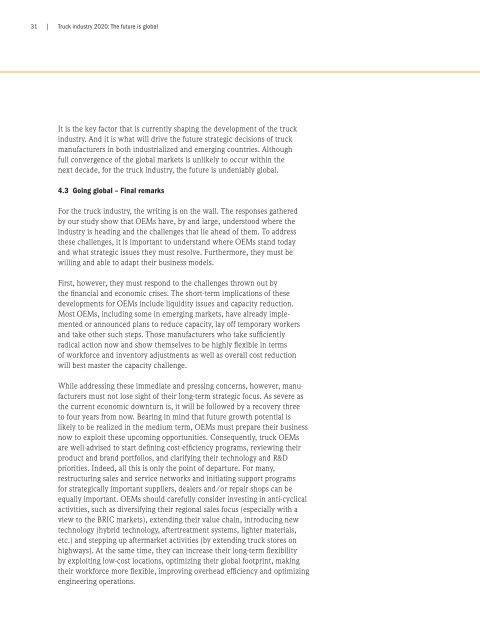Truck industry 2020: The future is global - Roland Berger
Truck industry 2020: The future is global - Roland Berger
Truck industry 2020: The future is global - Roland Berger
Create successful ePaper yourself
Turn your PDF publications into a flip-book with our unique Google optimized e-Paper software.
31 |<br />
<strong>Truck</strong> <strong>industry</strong> <strong>2020</strong>: <strong>The</strong> <strong>future</strong> <strong>is</strong> <strong>global</strong><br />
It <strong>is</strong> the key factor that <strong>is</strong> currently shaping the development of the truck<br />
<strong>industry</strong>. And it <strong>is</strong> what will drive the <strong>future</strong> strategic dec<strong>is</strong>ions of truck<br />
manufacturers in both industrialized and emerging countries. Although<br />
full convergence of the <strong>global</strong> markets <strong>is</strong> unlikely to occur within the<br />
next decade, for the truck <strong>industry</strong>, the <strong>future</strong> <strong>is</strong> undeniably <strong>global</strong>.<br />
4.3 Going <strong>global</strong> – Final remarks<br />
For the truck <strong>industry</strong>, the writing <strong>is</strong> on the wall. <strong>The</strong> responses gathered<br />
by our study show that OEMs have, by and large, understood where the<br />
<strong>industry</strong> <strong>is</strong> heading and the challenges that lie ahead of them. To address<br />
these challenges, it <strong>is</strong> important to understand where OEMs stand today<br />
and what strategic <strong>is</strong>sues they must resolve. Furthermore, they must be<br />
willing and able to adapt their business models.<br />
First, however, they must respond to the challenges thrown out by<br />
the financial and economic cr<strong>is</strong>es. <strong>The</strong> short-term implications of these<br />
developments for OEMs include liquidity <strong>is</strong>sues and capacity reduction.<br />
Most OEMs, including some in emerging markets, have already implemented<br />
or announced plans to reduce capacity, lay off temporary workers<br />
and take other such steps. Those manufacturers who take sufficiently<br />
radical action now and show themselves to be highly flexible in terms<br />
of workforce and inventory adjustments as well as overall cost reduction<br />
will best master the capacity challenge.<br />
While addressing these immediate and pressing concerns, however, manufacturers<br />
must not lose sight of their long-term strategic focus. As severe as<br />
the current economic downturn <strong>is</strong>, it will be followed by a recovery three<br />
to four years from now. Bearing in mind that <strong>future</strong> growth potential <strong>is</strong><br />
likely to be realized in the medium term, OEMs must prepare their business<br />
now to exploit these upcoming opportunities. Consequently, truck OEMs<br />
are well-adv<strong>is</strong>ed to start defining cost-efficiency programs, reviewing their<br />
product and brand portfolios, and clarifying their technology and R&D<br />
priorities. Indeed, all th<strong>is</strong> <strong>is</strong> only the point of departure. For many,<br />
restructuring sales and service networks and initiating support programs<br />
for strategically important suppliers, dealers and/or repair shops can be<br />
equally important. OEMs should carefully consider investing in anti-cyclical<br />
activities, such as diversifying their regional sales focus (especially with a<br />
view to the BRIC markets), extending their value chain, introducing new<br />
technology (hybrid technology, aftertreatment systems, lighter materials,<br />
etc.) and stepping up aftermarket activities (by extending truck stores on<br />
highways). At the same time, they can increase their long-term flexibility<br />
by exploiting low-cost locations, optimizing their <strong>global</strong> footprint, making<br />
their workforce more flexible, improving overhead efficiency and optimizing<br />
engineering operations.

















